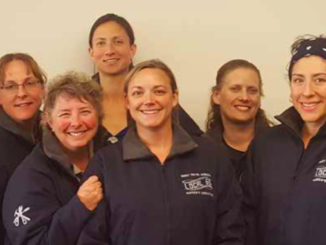
Results from the fourth annual Sheet Metal Journal outlook survey show that while we are not on the other side of COVID-19, we are definitely in the tunnel, moving toward the light.
By / Jessica Kirby
The survey focused on the activities, challenges, and opportunities SMACNA contractors in British Columbia faced in 2020 and those they expect to face in 2021. Respondents’ answers and perspectives were diverse. Most were optimistic and holding the line, choosing to focus on collectively and purposefully moving through this strange and challenging year. Creativity, thoughtfulness, and commitment to teamwork were at the forefront of most responses, proving once again that SMACNA-BC is backed by its members’ resilience and dedication to the industry.
The SMJ outlook survey is distributed though Survey Monkey each December via our friends at the SMACNA-BC office. The questions are developed based on the issues we discuss with contractors throughout the year, topics of relevance to the construction industry in general, and the answers from previous surveys that garnered the most response. When relating percentages, note they will seldom total 100% because respondents are free to select multiple answers for each question.
We appreciate the participation of everyone who took the time to answer, and encourage those who didn’t to watch for the link the next time it comes around, which will be in December 2021. Besides informing this article, it helps SMACNA-BC’s executive director and board of directors make important decisions about the 2021-22 budget and provides information on manpower loading and availability for the industry.
Who are our contractors?
The survey is distributed to SMACNA-BC’s mailing list and the number of respondents varies form year to year, as do their areas of specialty. Of the contractors who answered the survey this year, 78% specialize in HVAC, 22% in architectural metal, 22% in specialty, and 0% in TAB, keeping in mind some contractors have more than one specialty. Divided by sector, 44% work primarily in residential, 44% in commercial/institutional, and 11% in industrial.
For most contractors surveyed, 2020 was a good year. Sixty-seven percent said they performed much better than expected in 2020, 22% performed slightly above average, 11% performed the same as in 2019, and 33% were a little down. On the brighter side, zero respondents said 2020 was the worst year on record for their business.
Moving into the uncertainty and cautious optimism of 2021, 12% of contractors surveyed expect to perform better than they did in 2020. The majority (45%) expect to be on par with 2020, while 33% expect business to be slightly above average. Nearly 11% expect to be a little down from 2020, but no respondents said they are bracing for the worst.
Economists in British Columbia predict a slight rebound and moderate growth for the provincial economy in 2021. According to the Economic Forecast Council, BC is on track for real GDP growth averaging 4.7 percent in 2021 and 4.9 percent next year, but also says that change won’t be felt evenly across industries. Construction will remain on the high end of the recovery scale, driven by residential and commercial markets and infrastructure dollars.
2020 in Review
Over the past year, the pandemic has affected sheet metal contractors in many ways besides economically. For some, employee management has been difficult, and remote workers on the office side were harder to manage and keep motivated. In the field, construction workers often felt exposed and like they were living in a different world than the rest of the team who “get to hide,” said one respondent.
Nearly everyone had concerns about safety protocols on the job site making job sites less productive and costing contractors extra for administration, PPE, and supplies. In some cases projects have been delayed or cancelled, and of course face-to-face sales calls are out of the question. Organizing hours to account for working from home has been an important change for some contractors. Some say the new system works well, while others say motivation and accountability of work-from-home employees is difficult to manage.
Mental stress and anxiety among the workforce has become a top topic. Besides people taking sick time and productivity being affected, several contractors reported employees accessing counselling services on a regular basis. If nothing else, it has caused resilience and flexibility: “Covid has forced us to lean more towards educating and supplying our workforce with continually changing protocols,” one respondent said. Several shops adapted by closing their doors to anyone except staff, and every contractor who responded spent time and effort implementing social distancing, safety, and sanitizing measures with employee safety top of mind.
Of course, those measures were only the beginning. Sheet metal contractors adapted and pivoted in many ways, including finding new and creative ways to engage the workforce (45%), investing in labour (24%), and implementing new technology, including tracking, estimating, AutoCAD, and other software (22%). An equal number of respondents—13%—focused more heavily on productivity, increased the workforce, and decreased their workforce.
And, attention to productivity will be at the forefront of success in 2021 and 2022. According to a New Horizons Foundation study titled, “Pandemics and Productivity: Quantifying the Impact,” a random sample of over 20,000 labour hours collected from sheet metal, HVAC, and mechanical contractors indicates 8.7% of hours available on projects to do productive work are lost due to mitigation requirements, such as PPE management, cleaning and disinfection, access rules, and extra administration time.
The study indicates an overall 9.2% average productivity impact on sheet metal, HVAC, and mechanical contractor productivity resulting from the pandemic, and this is in addition to the mitigation impact of 8.7% to produce a total productivity impact of 17.9%
According to the study, that means contractors should use this information to price an equitable adjustment properly employing both the pandemic change order calculator provided with the study and the study itself as backup verification for the impact. (Email info@newhorizonsfoundation.org to receive a copy of the New Horizons study.)
“Companies that have trended lower in productivity losses have established, organized, and trained their teams with new pandemic mitigation processes and procedures,” the study says. “Additionally, they have monitored and shifted work activities to accommodate required distance working between team members.”
Exploring 2021
It is no secret that 2021 promises to be challenging on several fronts, including skilled labour, named as a prime challenge for 45% of contractors, competitive pricing (33%), political or economic markets (13%), too much work (12%), and capital investment (11%). Of course, more than 55% of contractors surveyed named COVID-19 as 2021’s greatest challenge.
Success in 2021 will mean staying competitive, something 56% of respondents said would come down to educating and training themselves and their workforce. Another 44% said the secret to remaining competitive would be studying and improving productivity, while an equal number (33%) says pricing competitively, retaining labour, and investing in technology were the best ways to get ahead of the competition in 2021.
Of course, we have to spend money to make money. The biggest investment category among contractors who responded is technology (55%), including project management software and AutoCAD. Following that were labour (34%), expanding operations (23%), education and training (22%), finding projects to bid (12%), and leaving the industry entirely (10%).
In the tunnel
While we are not through to the other side of COVID-19 yet, we are definitely in the tunnel and following the light, which is getting brighter for Canadians and British Columbians as we move into 2021. As of early March, 2,698,454 doses of approved COVID-19 vaccines have been administered across Canada, including more than 355,000 in British Columbia. Estimates around activity and investment in 2021-2022 are already far more optimistic than they were in late December, and all arrows point to continued progress in that direction.
As SMACNA contractors move into 2021, some have identified a gamut of opportunity—and others, not so much. While 45% said they have no idea what their greatest opportunity will be or that they don’t see any opportunities in 2021, others were optimistic. Several plan to keep looking forward prepared to adapt to whatever comes their way. Others see significant work on the horizon in infrastructure, hospitals, schools, and even condos, while others are looking ahead to invest in leadership, supervisory, and other professional development training for staff.
And finally one respondent was particularly optimistic about the silver lining in weathering the storm together: “Our greatest opportunity for 2021 is to stay together as a team. When we can get through a pandemic together, there is not much that can get in our way. Being there for each other strengthens the relationship.” ■



